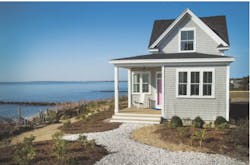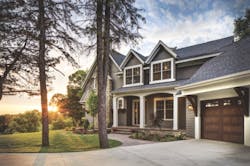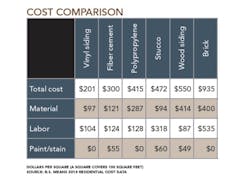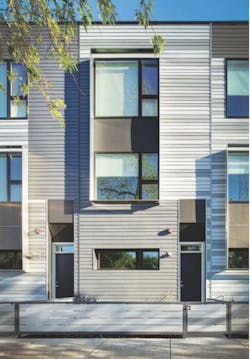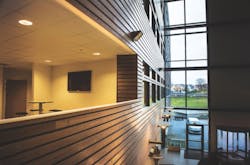Vinyl Siding Options: How to Choose the Right Siding for Your Home
June 23, 2015
12 min read
Of all the material decisions involved in the process of building your houses, selecting the siding is among the most important. Siding is the first line of defense against the elements, and it’s a vital part of the wall assembly. But it’s also, quite literally, the skin of the building and the first thing that people see from the curb, so it’s key to the home’s aesthetics. It can also take up a significant portion of the budget.
Vinyl Siding: Just One of the Many Options for Home Exteriors
The range of siding options is vast, consisting of a wide variety of materials that include vinyl, brick, fiber cement, cellular PVC, various types of wood, stone, manufactured stone veneer, stucco, synthetic stucco, aluminum, stainless steel, composites, ceramic tile, and more. So, which siding material do you choose? Which one is right for the type of houses you build? Which best suits the climate? Which one blends cost, looks, ease of installation, and durability?
For many builders, the answer to those questions appears to be vinyl siding—for the 20th straight year—according to the U.S. Census Bureau’s annual report, “Characteristics of New Single-Family Houses Completed.” In that report, vinyl ranks No. 1 for siding in 2013 (the most recent data available).
Vinyl Siding for Durability
“Vinyl siding was the predominant exterior wall material on
31 percent of the 569,000 homes built, compared with 25 percent for brick, 22 percent for stucco, and 16 percent for fiber cement,” says Kate Offringa, president of the Vinyl Siding Institute (VSI), a trade association in Washington, D.C. “Seventy-six percent of the homes built in the Northeast and 60 percent of homes built in the Midwest were first and foremost clad in vinyl siding.”
The material hits many touch points. Builders love it because it’s affordable and offers a variety of options and accessories. Subcontractors like it because it’s easy to install. Homeowners choose it because it’s affordable, requires little maintenance, and seemingly lasts forever. “The popularity of vinyl siding is driven by consumer demand,” Offringa says. “Builders build what homebuyers want: curb appeal, low maintenance, and long life.”
The vinyl industry says that the product—while essentially the same in terms of the material used—has changed quite a bit in the last 20 years. Vinyl siding now comes in bolder colors, more profiles, and with UV protection for increased durability. It’s even available as an insulated product for added energy efficiency, and some manufacturers offer products that mimic cedar shakes and board-and-batten siding. Accents and decorative trim enhancements are some of the biggest trends, says Brian Kirn, senior marketing manager for the Siding Products Group at Valley Forge, Pa.-based CertainTeed, a company that offers 18 lines of vinyl siding and accessories.
But vinyl siding isn’t king in every region of the country. According to the Census Bureau report released in October 2014, brick led the South with 42 percent of new homes in 2013 (and is the second most popular cladding in the U.S.).
Brick for Exteriors Is Enduring
Not surprisingly, the Reston, Va.-based Brick Industry Association (BIA) claims that brick is the ultimate material. “What began as a building essential in the Near East and India more than 5,000 years ago,” the association says, “wound its way through the ancient Egyptians, the Indus Valley civilization, and the Romans and today has amazingly become the all-American building product throughout our country’s history.”
Brick won’t rot, dent, or need to be painted, and it will never tear or be eaten by termites, the BIA says. Multiple studies, the association claims, also show that genuine clay brick beats competitive exteriors in wind, moisture, and earthquake resistance, and protection from wind-blown debris. The group adds that several studies prove that genuine clay brick offers greater sustainable value over its top competitors—including vinyl, concrete masonry, manufactured stone, fiber-cement siding, and synthetic stucco (also known as exterior insulation and finish system or EIFS).
“Fired clay brick is the greenest building material made in America, and is made from abundant natural resources,” says Ray Leonhard, president and CEO of the BIA. “A product that’s so durable, it has a life span lasting generations, even centuries; colors that will not fade over time; superior sound reduction and energy performance; low maintenance; and high resale values are just some of the benefits of genuine clay brick construction. No other wall cladding material can come close to offering all these benefits.”
Plaster for Exteriors: Hardy and Versatile
In the West, brick takes a back seat to stucco, which, according to the Census Bureau’s report, accounted for about 58 percent of the market in that part of the country. The system—consisting of Portland cement, sand, lime, and water applied over lath in three coats—is versatile enough for any climate, the stucco industry says.
“Stucco, or Portland cement plaster, is a versatile facing material that can be applied to flat or curved surfaces either inside or outside any building or structure,” the Portland Cement Association website says. “Stucco has great appeal as a surface finish because of its utility, low first cost, and minimum need for maintenance.”
Though different in application, synthetic stucco often looks the same as traditional stucco. Instead of lath and plaster, however, a polymer-based coating is troweled onto rigid insulation board fastened to the exterior wall. The benefit of the system is that it leads to a more energy-efficient home, eliminating thermal bridging and reducing air and moisture penetration, says West Warwick, R.I.-based Dryvit Systems. Of course, synthetic stucco had to overcome a public relations nightmare in the 1980s, when many installations experienced moisture issues that led to failure. Dryvit stands behind its products, and the industry as a whole says all the issues and problems with EIFS have been corrected.
MORE INFO: Manufacturer Innovation Means Plenty of Siding Options for Builders
Cement Board Siding Still Gaining Ground
Fiber cement is a not-so-new player that has steadily risen in popularity since the 1990s. Made from a mixture of cement, sand, and cellulose that’s cured using pressurized steam, fiber-cement siding is available in traditional shiplap boards and in panels. It’s intended for those who want the look of wood without the hassles and costs of maintenance. “Fiber-cement siding should be more durable than wood—it is termite-resistant, water-resistant, noncombustible, and warranted to last 50 years,” says NAHB’s ToolBase Services, the website of Home Innovation Research Labs, in Upper Marlboro, Md.
Fiber-cement siding options have become popular with architects and urban developers, such as Ranquist Development Group, in Chicago. Whether it’s single-family homes, attached rowhouses, or condo buildings, the firm considers fiber-cement siding for every project, says vice president John T. Pawlicki.
“We’re predominantly using HardiePlank on our single-family homes, but for one of our 50-unit buildings in the city, we’re using a [fiber-cement] product made by Nichiha,” Pawlicki says. “It’s a fantastic product. It’s a little expensive compared to the Hardie product, but it gives a clean, modern look and comes with a great warranty.”
Wood Use for Siding Declining
One siding material whose market share has steadily declined is wood. Representing a mere 5 percent of the siding market in 2013 (compared with 44 percent in 1981), wood has fallen out of favor, except with hardcore holdouts, such as custom builders and high-end architects. One rare development where wood is still the default material is Heritage Sands, on Cape Cod, Mass.
Consisting of 63 vacation homes, each measuring 900 square feet to 1,350 square feet, the project combines classic architecture, smart design, and energy-efficient systems. It only uses pre-stained Eastern white cedar shingles from Maibec in Quebec, Canada. Developer Rob Brennan says that when assessing siding options, the decision to side with cedar was a no-brainer. “We wanted to bring back the authentic oceanfront Cape Cod cottage,” Brennan says. The company worked with the architect—Union Studio, in Providence, R.I.—to hold true to the character and traditions of the region, which meant using wood, not vinyl or fiber-cement siding.
“I’ve had a fair amount of experience with fiber cement, and it’s not a product I would support here,” says Heritage Sands’ construction manager John Hutchins. “It doesn’t hold up as well as wood, even the pre-finished products I’ve worked with. Vinyl siding lasts forever, but it was not an option because of the aesthetics and what we’re trying to create.”
Wood Products That Offer Fresh Siding Options
The wood category has seen many new products promising to eliminate the maintenance and inherent issues associated with the material. They go by such names as Thermory, Kebony, Accoya, and ThermoWood.
“Thermally modified wood is a process whereby North American ash is shipped to Estonia, where it is placed under heat and steam,” says Kevin DeMars, principal of Thermory USA, in Wilmette, Ill. “There are no chemicals in the process at all.” The heat-treatment process does three things, DeMars continues: “It changes the color, making it dark; it gives it stability, by reducing the amount of moisture the wood takes on and gives off; and it gives it exceptional rot resistance. It will behave much like regular ash, and last just as long or longer than any of the tropical species.”
A premium product that’s priced like tropical hardwoods, Thermory comes in several siding profiles, but most orders are for custom projects. It can be painted, but that defeats the purpose of the product. “If you want a painted siding, there are lots of other options,” DeMars says. “Usually, you’re going with our product because you want the look of wood."
Though the breadth of innovative siding products is vast, production builders rarely venture past vinyl, brick, fiber cement, and stucco. One explanation is regional.
There are also a variety of products that currently have limited market share but have loyal users who swear by the products’ performance. And there are newer products with ambitious goals, as well. That list includes LP SmartSide, a not-so-new treated engineered wood product with the look of wood; BarkClad natural bark or engineered bark siding; EcoClad composite from Klip BioTechnologies; various wood/resin products from Europe; and others.
Though the breadth of innovative siding products is vast, production builders rarely venture past vinyl, brick, fiber cement, and stucco. One explanation is regional. Siding choices often parallel the predominant housing styles of an area—stucco for the Spanish style in the West and Southwest, shiplap for the Colonial in the Northeast. Consequently, a region creates its own specialized labor pool, such as bricklayers or stucco masons, which helps keep installation costs in check.
The regional consideration also applies to weather. Most siding materials, correctly installed and maintained, could last well in any climate, but some will siding options require significant maintenance, so builders choose those materials that do well in local weather conditions—intense sun, heavy rainfall, freeze/thaw cycles. It’s partly the reason why stucco is popular in the arid West while brick is preferred in the South.
But the biggest driver in siding decisions is often cost. Production builders are sensitive to pricing. Vinyl assuages those concerns. Citing R.S. Means’ 2014 Residential Cost Data, VSI says that vinyl has an installed cost of $201 per square, while fiber cement costs $300, stucco costs $472, wood siding is $550, and brick clocks in at $935. The fact that homebuyers view brick as a premium, desirable product is the reason why many Mid-Atlantic and Northeast builders use brick on the front of the house and fiber cement or vinyl on the sides and rear.
Ultimately, when selecting siding, builders will choose what works for them and their buyers—and their budgets.
The Best Defense Against Water Intrusion
Water will penetrate siding. It’s inevitable.
“People continue to put their faith in every kind of cladding material, but in the real world, all claddings leak sooner or later,” building scientist Joseph Lstiburek has said. “They always have, and they always will.”
What’s important is how the wall assembly handles the water intrusion.
We now know that siding pressed tightly against the weather resistive barrier (WRB) and support wall isn’t a good idea. This system doesn’t promote air circulation and won’t allow the wall assembly to dry out. The solution: Include a rainscreen system for moisture management.
In the wall assembly, providing an air gap between the back of the cladding and the WRB promotes air circulation and lets the cladding dry out, enhancing the durability of the exterior wall system. This rainscreen installation serves to “drain the rain.” “[It] sheds most of the rain and manages the rest, preventing moisture intrusion and the resulting premature decay in homes,” the NAHB’s ToolBase Services website says. It controls wetting forces of gravity, capillary action, and wind pressure differences.
Because water will surely work its way past the siding, adequate flashing at every opening and penetration is essential, as are weep holes at the bottom of the wall (and often at the top of the wall as well).
You can opt to create the rainscreen in the field, or choose from a range of off-the-shelf rainscreen systems that are now available. EIFS manufacturers have incorporated an airspace into their products as well to allow water to drain.
Though ideal for painted wood siding because the rainscreen manages moisture that can reduce the life of the siding, any siding material can benefit. Brick siding installations, in the form of brick veneer cavity walls, have always included an airspace, and some consider brick to be the original rainscreen.
Though relatively easy to execute, for the rainscreen to be effective, it’s important to get the details right. There will be some added material costs for furring strips and some extra labor for detailing, but the rainscreen will prevent premature decay of a home’s siding and structure.
Sign-up for Pro Builder Newsletters
Get all of the latest news and updates.
